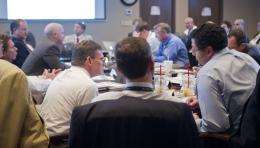Space launch system program completes step one of combined milestone reviews

America's next heavy-lift launch vehicle -- the Space Launch System -- is one step closer to its first launch in 2017, following the successful completion of the first phase of a combined set of milestone reviews.
The SLS Program has completed step one in a combined System Requirements Review and System Definition Review -- both extensive NASA-led reviews that set requirements to further narrow the scope of the system design and evaluate the vehicle concept based on top-level program requirements. The reviews include setting launch vehicle requirements for crew safety and interfacing with the Orion Multi-Purpose Crew Vehicle to carry it to deep space as well as the ground operations and launch facilities at NASA's Kennedy Space Center in Cape Canaveral, Fla. Additionally, the reviews set cost and schedule requirements to provide on-time development.
"It's exciting to see how far this program has come in such a short time," said Todd May, SLS program manager at NASA's Marshall Space Flight Center in Huntsville, Ala. "Completion of this first step of reviews moves the nation's first deep space rocket from concept development to preliminary design."
The milestone reviews are two in a series of life-cycle reviews advancing the vehicle from concept design to flight readiness. Step one included a focused technical review of the program requirements with information on cost, schedule and risk. A standing review board comprised of technical experts from across the agency evaluated SLS program documents including vehicle requirements, specifications, plans, studies and reports. The board ensured specific criteria were met and confirmed that requirements are complete, validated and responsive to mission requirements.
The combination of the two reviews as well as safety and reliability analyses is a fundamentally different way of conducting program reviews. The SLS team is streamlining processes to provide a safe, affordable and sustainable rocket.
"This checkpoint gives us a mature understanding of the requirements, solidifies the vehicle concept design will meet all the requirements of the program and mission and signals that SLS is ready to begin engineering design activities," added May. "We're moving forward to deliver a new national capability to get America exploring space again."
Step two, which will begin in early summer, will include an integrated assessment of the technical and programmatic components fully evaluating cost, schedule and risk involved with the program.
The Space Launch System will provide an entirely new capability for human exploration beyond Earth orbit, taking astronauts farther into space than ever before. It also can back up commercial and international partner transportation services to the International Space Station. Designed to be flexible for crew or cargo missions, the SLS will continue America’s journey of discovery from the unique vantage point of space. The Marshall Space Flight Center is leading the design and development of the rocket that can take us to the asteroids, Lagrange points – positions in space where a satellite or science instrument could be stationed in a relative steady state –the moon, and eventually to Mars.
More information: For more information about SLS, visit: www.nasa.gov/sls
Provided by JPL/NASA


















